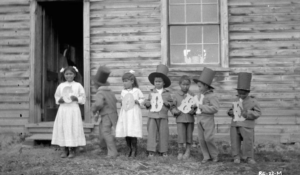Unless you’ve been living under a rock, you should be aware of the travesties of Native American “residential schools” that were put in place to strip indigenous people of their heritage, while assimilating them into modern day society. The schools were literally founded to “break” the spirits of the children that attended them. Some of those children were so broken, that they never made it back home – years later they were found buried on the grounds of the schools, in what has become a horrific wakeup call pertaining to the past and current living conditions of a proud people that were driven from their homelands and largely bypassed and forgotten.
I recently spoke to musician, activist, educator, behavioral specialist, and mental health counselor, Ed Koban (Mohawk) who not only provided me with valuable insight into the attempts of educators to force assimilation upon indigenous youth, he also delved into the lasting traumas caused at the hands of educators at the residential schools.
For years, children were plucked from the arms of their mothers, to be delivered to these foreign schools, where everything that they knew was swiftly eviscerated from their senses of being. The schools would essentially tame the savage, while instilling a new moral code. It started with the cutting of the hair, forced disuse of their native tongue, clothing acculturation, assigned number designations, and devolved from there.
To get a clearer picture of the scope of the schools, watch Unseen Tears: The Native American Residential Boarding School Experience in Western New York.
A lot of survivors never talked about it,” said Koban. “These were dirty secrets – they were too proud to talk about what happened. But people are starting to wake up. They are hearing about what happened when the Canadian and American government took the children hundreds of mile from their homes and subjected then to mental and physical abuse. Those who made it home were the lucky ones. They’ve been digging up over 7000 bodies of children that never made it home, for whatever reasons. Now people are asking, ‘Why have I never heard of this before?’ Over the summer, Canada started the Truth and Reconciliation Committee that is helping to tell the stories.”
At the same time, Koban is looking to enlighten a broader audience about the scars that are still fresh, which is why he is hosting a multimedia event titled Unburied Truth: The History, Trauma & Aftermath of the Native American Residential School Policy. The event, to be held on Sunday, November 14 (6:30pm) at Taylor Theater on the Kenan Center Campus is described thusly:
In May of 2021, the remains of 215 indigenous children were discovered buried in unmarked graves on the grounds of the Kamloops Indian Residential School in British Columbia, Canada. Since the initial 215, thousands more have been discovered throughout the USA & Canada, with dozens more residential school site to be searched, and the number climbs. As much a story of perseverance, as it is tragedy, we will dive into one of the darkest parts of our history. The History of the Native American Residential School Policies (that lasted into the 1990’s) in both the United States and Canada, came to be, the tragic and criminal events that took place. and the trauma that has had a profound and lasting impact on the indigenous people of North America and how they have persevered, in spite of it all.
Currently, Koban is traveling the country as a mental health counselor. Previously, he worked at Lewiston-Porter School for 20 years. Throughout his years of playing and teaching, he has tried to help heal the wounds of his community – part of the Iroquois Confederacy. He does this by bringing to light the inequities and problems, without overly-politicizing the issues.
“Native Americans are probably more stereotyped than any other culture – the noble savage, the alcoholic, the environmentalist,” lamented Koban. “But our culture survives in spite of it. And the residential schools are now closed. There have been movies, books, and songs, but it’s such a dark subject (the losses and travesties) that it never gained any traction. Just think – you take children away from their families starting at 5 years old… and you do that for generations. It doesn’t just disrupt the community and the heritage, it leads to worse things, like alcoholism and suicide.”
Ed Koban | Photo by Michael Mietlicki
Koban and I discussed the current climate in the US, with the Black Lives Matter movement, among other wakeup calls.
“We are finally at a time when we can talk about all of this, and people are willing to listen,” Koban told me. “It’s the perfect storm right now – we need to keep the conversations going.”
Koban is hoping that people come out and listen to the conversation on Sunday, November 14 (6:30pm) at Taylor Theater on the Kenan Center Campus. This is a free event to attend. Koban will play his flute and guitar at the event, which should run about an hour.
Ed Koban is Musical Director and House Band Coordinator for the Native American Music Awards and Host of the NAMA Podcast (Native American Music Association)
Find his music on Spotify, and YouTube.
Lead image: Children at Fort Simpson Indian Residential School holding letters that spell “Goodbye,” Fort Simpson, Northwest Territories, 1922 | File source: J. F. Moran, Wikimedia Commons

